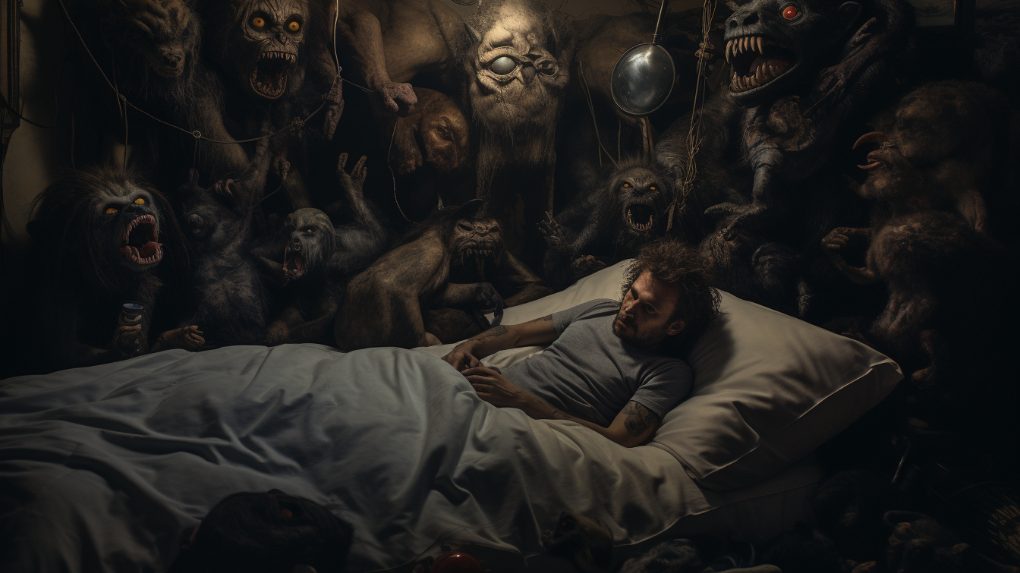Sleep paralysis is a sleep disorder that occurs when a person is on the verge of falling asleep or waking up and finds themselves temporarily unable to move or speak.
The experience can last for only a few minutes, but for many, it feels like an eternity. This terrifying phenomenon is often accompanied by hallucinations, including the sensation of an evil entity or shadow person looming over them.
The Science Behind Sleep Paralysis
From a medical standpoint, sleep paralysis occurs when our body’s mechanism to keep us from acting out our dreams, known as REM atonia, carries over into our waking life. This means that while the mind becomes conscious, the body refuses to wake, leaving one paralyzed.
Although harmless, the experience can be distressing, particularly when accompanied by vivid and sometimes terrifying nightmares.
How Sleep Disorders Are Portrayed in Films
Film is a medium that often captures the essence of human experiences, both ordinary and extraordinary. Sleep disorders, including sleep paralysis, have found their way into many movies, providing a mix of horror, drama, and occasionally even comedy. Horror movies, in particular, have exploited the terrifying aspects of sleep paralysis to great effect. However, it’s essential to distinguish between the cinematic portrayal and the real-life experiences of those suffering from this disorder.
Related: What Triggers Sleep Paralysis? Analyzing Its Common Culprits
The History of Sleep Paralysis in Movies
The Ancient Concept of Sleep Demons
Long before the age of cinema, sleep paralysis was believed to be the work of sleep demons or supernatural events. Ancient cultures often depicted shadowy figures or demons pressing down on sleeping individuals, a sensation many with sleep paralysis can relate to. These historical interpretations are crucial in understanding the basis for many modern horror films that deal with this topic.
From Night Terrors to the Big Screen
Over the years, sleep paralysis transitioned from folklore to film. Directors and screenwriters recognized the innate horror potential of the condition. Night terrors, hallucinations, and the sheer helplessness felt during a paralysis episode have become fodder for countless spine-chilling scenes in movies. This transition, however, hasn’t been without its share of exaggerations and misconceptions.
Notable Sleep Paralysis Movies
Dead Awake: A Terrifying Tale of Sleep Paralysis
“Dead Awake” is a film that delves deep into the harrowing world of sleep paralysis. A young woman finds herself plagued by recurring nightmares, only to realize that these aren’t just dreams but a direct consequence of an ancient evil entity tied to sleep paralysis. The film explores the concept of the sleep demon, taking audiences on a journey filled with fear, suspense, and a desperate race against time.
Nightmare on Elm Street: Freddy Krueger’s Dream World
One of the most iconic horror movies, “Nightmare on Elm Street,” brings forth the terrifying Freddy Krueger, a vengeful spirit that haunts and kills teens in their dreams. While not entirely focused on sleep paralysis, the film blurs the lines between the dream world and reality, echoing the very essence of sleep paralysis, where one feels trapped between sleep and wakefulness.
Waking Life: A Dive into Lucid Dreams
“Waking Life” is not a horror film per se, but it brilliantly captures the concept of lucid dreaming and the thin line between dreams and reality. The film follows a young man’s journey through a series of philosophical conversations, pondering life, death, and the nature of dreams. The movie beautifully juxtaposes the intriguing world of dreams with the jarring moments of waking life.
Shadow People: The Sleep Paralysis Demon
“Shadow People” dives into the terrifying phenomenon where individuals, while paralyzed in their sleep, witness shadowy figures looming over them. Directed by Matthew Arnold, this film builds its narrative around a radio talk show host who delves into stories of these eerie shadow entities. As the story progresses, he finds himself facing the very horrors his callers describe, making for a gripping watch.
Sleep: A Documentary Approach
“Sleep” is a unique take on the subject, taking a documentary-style approach to explore sleep disorders, especially sleep paralysis. By juxtaposing real-life testimonials with dramatized reconstructions, it offers a profound insight into the terror, confusion, and desperation felt by those who experience this phenomenon.
Also read The Haunting of the Annabelle Doll: The True Story Behind the Horror Film
Characters and Their Struggles
The Young Woman in Dead Awake
In “Dead Awake,” the central character is a young woman named Kate Bowman, portrayed by Jocelin Donahue. She is tormented by nightmares and finds herself in a grim battle with an ancient evil known as the “Night Hag.” As her family and friends fall victim to this evil entity, her desperation and fear escalate. The portrayal is a raw and intimate look at the emotional toll sleep disorders can inflict.
The Boy Who Suffers in Horror Films
Many horror movies, such as “Insidious” and “Before I Wake” by Mike Flanagan, showcase young boys who grapple with their nightmares, which often have a basis in sleep paralysis. Their innocent and vulnerable portrayal amplifies the audience’s fear and empathy, making the horror even more palpable.
The Radio Talk Show Host’s Experience
In “Shadow People,” Dallas Roberts plays the role of a radio talk show host named Charlie Crowe. As he delves into the mysteries of sleep paralysis and the shadow people, he becomes a central figure in the narrative. Crowe’s skepticism turns to horror as he confronts the reality of these phenomena, emphasizing the blurring lines between skepticism and belief.
The Sleep Doctor’s Perspective
Movies like “Slumber,” where Maggie Q plays a sleep doctor named Alice Arnolds, give insight into the medical perspective. Dr. Arnolds, in her quest to help a family plagued by sleep paralysis, finds herself facing her own demons. Her character is a reminder that even those who understand the science can fall victim to the terrifying realities of this disorder.
The Social Worker’s Tale
Jonathan Hopkins’ “Slumber” showcases another perspective, this time of a social worker who witnesses a family’s descent into the horrors of sleep paralysis. The social worker, played by Kristen Bush, becomes pivotal in trying to decipher the line between mental health issues and supernatural occurrences.
You may also like Lucid Dreaming Tips – Unpacking the Best Strategies for Lucid Dreamers
The Reality vs. The Fiction
Real Life Stories of Sleep Paralysis
Away from the silver screen, countless individuals suffer from sleep paralysis in their everyday lives. While movies often dramatize events, real-life episodes can be just as terrifying. Accounts of being unable to move while sensing an evil presence in the room are common, with many feeling an inexplicable weight on their chest.
How Movies Exaggerate the Fear
While films need to engage and captivate audiences, they sometimes tend to exaggerate or over-dramatize certain events. In the case of sleep paralysis, movies often intensify the horror element, introducing supernatural events or evil entities. This can inadvertently perpetuate myths and misunderstandings about a medical condition that many face.
The Truth Behind the Horror
Sleep paralysis, while terrifying, is not the result of evil entities or malevolent forces. It’s a sleep disorder, often linked to factors like stress, disrupted sleep schedules, and certain mental health conditions. It’s essential for viewers to understand the distinction between cinematic portrayal and the genuine medical phenomenon.
Don't miss What Happens When You Don’t Get Enough Sleep?
The Science Behind The Fear: Sleep Studies and Paralysis
Many individuals often fall asleep thinking they are safe from the worries of the waking world. Yet, as some films depict, this state of rest can be anything but peaceful. Sleep studies have shown that the body paralyzes itself during the REM phase of sleep, a natural mechanism to prevent us from acting out our dreams. But when this process is interrupted or misfires, the terrifying state of sleep paralysis can ensue.
The Tale of the Boy Who Suffers
In a lesser-known indie film available on Prime Video, we follow the narrative of a young boy who suffers from frequent episodes of sleep paralysis. His experiences become the talk of the town, leading him to be wrongly institutionalized in a mental institution. The story deepens as it explores the fine line between medical misinterpretations and genuine supernatural occurrences.
Venturing Beyond Horror: Sci-fi Interpretations
While most sleep paralysis movies lean heavily into the horror genre, there are a few sci-fi gems that delve into the subject from a futuristic perspective. A notable mention is “Beyond the Darkness,” starring Craig Conway. The plot revolves around a future where sleep studies have become advanced enough to allow individuals to control their dreams. However, matters get worse when these dream worlds start to merge with reality, blurring the lines between wakefulness and sleep.
Related Article Why Did My Dream Feel So Real? – Examining Possible Causes
The Impact of Sleep Paralysis Films
Why We Are Drawn to Sleep Paralysis Movies
The allure of sleep paralysis movies lies in their ability to tap into a primal fear: the vulnerability we feel when we are asleep. The idea that something malevolent can target us at our most defenseless moments is deeply unsettling. Moreover, the experience of sleep paralysis, where one feels trapped between the dream world and reality, resonates with many, given that a significant portion of the population has experienced it at least once in their lifetime. Horror movies, in essence, allow us to confront these fears in a controlled environment, which might explain their widespread appeal.
The Role of Horror Movies in Spreading Awareness
While horror films often dramatize and exaggerate for entertainment, they inadvertently play a role in bringing issues to light. In the case of sleep paralysis, these movies have raised awareness about a condition that was once shrouded in mystery and misconceptions. As audiences watch characters navigate the terror of sleep paralysis, they gain a window into the challenges faced by real-life sufferers. This heightened awareness can lead to a better understanding and empathy for those grappling with sleep disorders.
Concluding Thoughts
The Thin Line Between Reality and Film
Sleep paralysis movies offer a gripping blend of reality and fiction. While they capture the terror of the phenomenon, it’s crucial for viewers to remember the line between cinematic horror and real-life experiences.
Films often venture into the realm of supernatural events and evil entities to intensify the fear factor. In contrast, the real-life experience of sleep paralysis, although deeply unsettling, is a sleep disorder with scientific explanations.
Movies have the power to inform, inspire, and influence. As viewers, it’s our responsibility to approach these portrayals with a discerning eye, recognizing the distinction between the dramatized horrors on screen and the genuine challenges faced by individuals in their waking lives.
Additional Movies Worth Watching
For those intrigued by the portrayal of sleep paralysis in films, here are a few more titles that delve into related topics:
- Before I Wake: Directed by Mike Flanagan, this film explores the story of a young boy whose dreams (and nightmares) manifest into reality. The intertwining of dreams with waking life brings forth a poignant narrative on grief, loss, and hope.
- Insidious: A horror movie that delves into astral projection and the dangers lurking in the dream realm. As a family tries to save their boy trapped in a comatose state, they confront a world filled with malevolent spirits.
- The Nightmare: A documentary-style film by Rodney Ascher that presents personal stories of eight individuals tormented by sleep paralysis. This movie offers a haunting glimpse into their nightly horrors, interspersed with dramatic reenactments.
- Mara: A criminal psychologist finds herself investigating a series of strange deaths, only to discover they are linked to a demonic entity that paralyzes and kills its victims in their sleep.
- Sleep Tight: A Spanish psychological thriller that showcases the dark obsessions of a man who sneaks into apartments to watch people as they sleep, invoking themes of vulnerability and the disturbing idea of being watched during our most defenseless moments.
While the world of sleep paralysis movies is filled with chilling tales, they serve as a testament to cinema’s power to bring to light the complexities of human experiences, even those that occur in the shadowy realm between sleep and wakefulness.
Exploring Related Themes on Prime Video
For enthusiasts looking to delve deeper, Prime Video offers an array of films with clipboard-related topics. From intricate narratives set in mental institutions to stories highlighting the complex relationship between a husband and wife facing nocturnal terrors, there is no dearth of content exploring the boundaries of sleep and consciousness.
The Unexpected Darkness
In another gripping movie, “The Pull of the Darkness,” a man finds himself unable to kill the recurring visions of his wife, who haunts him every time he tries to fall asleep. Is she a manifestation of his guilt, or is there a more sinister force at play? The film challenges viewers to discern reality from illusion, using the backdrop of sleep paralysis.
Reflecting on the Power of Cinema
Cinema holds a mirror to society, reflecting our deepest fears, aspirations, and experiences. Through the portrayal of sleep paralysis, films not only entertain but shed light on a mysterious phenomenon, encouraging dialogue, empathy, and understanding. As audiences, our journey through these narratives enriches our perspective on the fine line between dream and reality.



